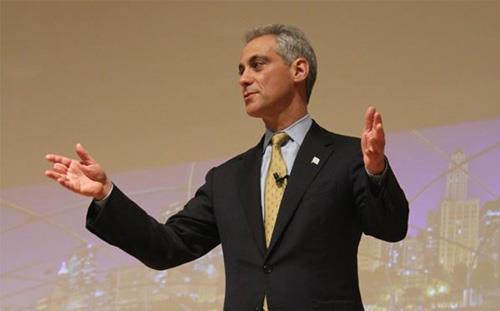
Chicago has always been a city where things come together. East and West America. Black and White America, as a destination for the Great Migration of Southern Blacks starting in the 1930s.
City So Real, an ambitious five-part documentary that premieres at 7 p.m. ET on Thursday on National Geographic, explains how Chicago's coming-togethers have not always been genteel and neighborly and looks at the ways Chicago is trying to untangle them today.
Created by documentarian Steve James, a Chicago native with a clear passion for the complex tapestry of the town, much of City So Real revolves around the 2019 mayoral election campaign.
It begins a year earlier when incumbent Mayor Rahm Emanuel (top) surprises the city by announcing he will not seek reelection.
Emanuel had been under fire for what critics saw as the city's evasive response to the death of teenage Laquan McDonald at the hands of a policeman.
A number of candidates had already lined up to challenge Emanuel, and after his withdrawal, the field ballooned to 21.
That's a lot of people with a lot of viewpoints, their sheer mass often producing a need to shout as loudly as possible to be heard over the others.
To an extent, then, City So Real documents a food fight, with enough anger and accusation in the air that it's hard for any candidate to seem calm and dignified.
That doesn't suggest the candidates aren't deadly serious, however, and one of the strengths of City So Real lies in its clear distillation of the multiple issues facing Chicago.
These aren't fundamentally different from urban issues elsewhere in America: the affordability of housing, the stability of neighborhoods, the concerns of long-timers about the ambition of newcomers. Plus, of course, American issues like race and gender and the levelness of the playing fields.
In the first episode, the proprietors of the Hideout, a local tavern where a trio plays blues music on the front porch, point across the street to an 18-acre tract of now largely vacant land sold by the city to developers.
It is billed as the future home of Lincoln Yards, a massive multi-use development incorporating office space, retail, recreation, and housing. Its components will soar dozens of stories into the sky and, when completed, presumably not for some years, chase vestigial neighborhood gathering spots like the Hideout into the amber mists of history.
Progress or desecration?
At the same time, while the city weighs that sort of philosophical question, thousands of residents aren't waiting and debating. They're taking to the streets.
Judging from City So Real, Chicago might be the street rally capitol of the world, and by the fifth episode, things have surged to the next level with reaction to the death of George Floyd.
In Chicago, as in other cities, the killing of Floyd by a Minneapolis police officer galvanized long-simmering concerns that Americans of color were not protected by the same standards of justice as White folks. While organizations like Black Lives Matter were already in play, Floyd's death gave their warnings a face that was hard to ignore.
James doesn't claim to find some magic solution that will resolve the multiple issues facing Chicago. He explains the most important among those issues, with their historical backdrop, and records the ways in which people in and out of power propose to address them.
Unsurprisingly, City So Real will resonate most strongly with those who live in or know Chicago. By making the city a character, with a large cast of supporting players, James turns the story into a wider drama.